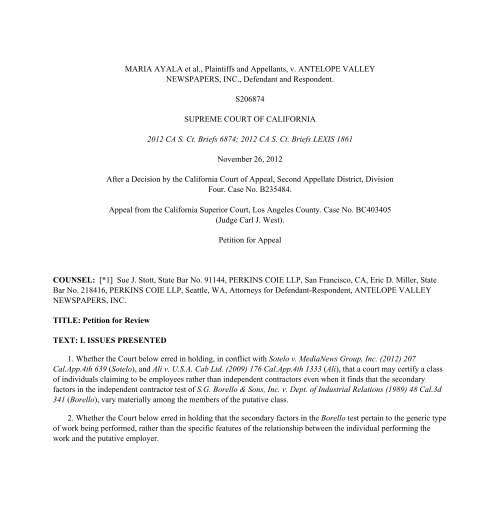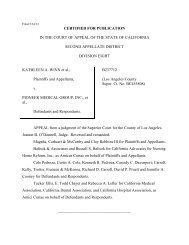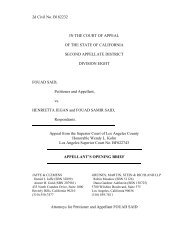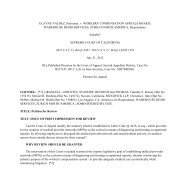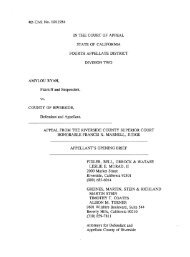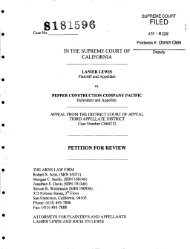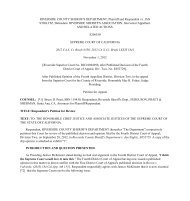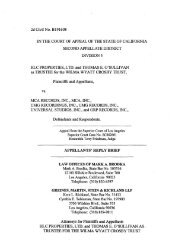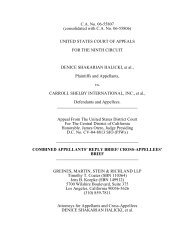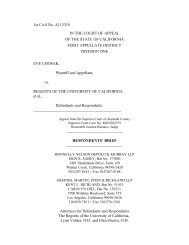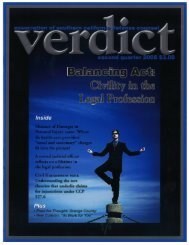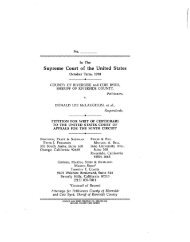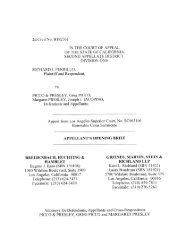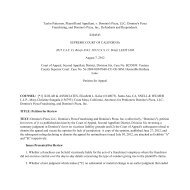MARIA AYALA et al., Plaintiffs and Appellants, v. ANTELOPE ...
MARIA AYALA et al., Plaintiffs and Appellants, v. ANTELOPE ...
MARIA AYALA et al., Plaintiffs and Appellants, v. ANTELOPE ...
You also want an ePaper? Increase the reach of your titles
YUMPU automatically turns print PDFs into web optimized ePapers that Google loves.
<strong>MARIA</strong> <strong>AYALA</strong> <strong>et</strong> <strong>al</strong>., <strong>Plaintiffs</strong> <strong>and</strong> <strong>Appellants</strong>, v. <strong>ANTELOPE</strong> VALLEY<br />
NEWSPAPERS, INC., Defendant <strong>and</strong> Respondent.<br />
S206874<br />
SUPREME COURT OF CALIFORNIA<br />
2012 CA S. Ct. Briefs 6874; 2012 CA S. Ct. Briefs LEXIS 1861<br />
November 26, 2012<br />
After a Decision by the C<strong>al</strong>ifornia Court of Appe<strong>al</strong>, Second Appellate District, Division<br />
Four. Case No. B235484.<br />
Appe<strong>al</strong> from the C<strong>al</strong>ifornia Superior Court, Los Angeles County. Case No. BC403405<br />
(Judge Carl J. West).<br />
P<strong>et</strong>ition for Appe<strong>al</strong><br />
COUNSEL: [*1] Sue J. Stott, State Bar No. 91144, PERKINS COIE LLP, San Francisco, CA, Eric D. Miller, State<br />
Bar No. 218416, PERKINS COIE LLP, Seattle, WA, Attorneys for Defendant-Respondent, <strong>ANTELOPE</strong> VALLEY<br />
NEWSPAPERS, INC.<br />
TITLE: P<strong>et</strong>ition for Review<br />
TEXT: I. ISSUES PRESENTED<br />
1. Wh<strong>et</strong>her the Court below erred in holding, in conflict with Sotelo v. MediaNews Group, Inc. (2012) 207<br />
C<strong>al</strong>.App.4th 639 (Sotelo), <strong>and</strong> Ali v. U.S.A. Cab Ltd. (2009) 176 C<strong>al</strong>.App.4th 1333 (Ali), that a court may certify a class<br />
of individu<strong>al</strong>s claiming to be employees rather than independent contractors even when it finds that the secondary<br />
factors in the independent contractor test of S.G. Borello & Sons, Inc. v. Dept. of Industri<strong>al</strong> Relations (1989) 48 C<strong>al</strong>.3d<br />
341 (Borello), vary materi<strong>al</strong>ly among the members of the putative class.<br />
2. Wh<strong>et</strong>her the Court below erred in holding that the secondary factors in the Borello test pertain to the generic type<br />
of work being performed, rather than the specific features of the relationship b<strong>et</strong>ween the individu<strong>al</strong> performing the<br />
work <strong>and</strong> the putative employer.
II. INTRODUCTION AND STATEMENT OF THE CASE [*2]<br />
A. Introduction<br />
2012 CA S. Ct. Briefs 6874; 2012 CA S. Ct. Briefs LEXIS 1861, *1<br />
This Court's review is required to resolve a direct conflict b<strong>et</strong>ween the published opinion of the Second Appellate<br />
District in this case <strong>and</strong> the decisions of the First Appellate District in Sotelo, supra, 207 C<strong>al</strong>.App.4th 639, <strong>and</strong> the<br />
Fourth Appellate District in Ali, supra, 176 C<strong>al</strong>.App.4th 1333. In <strong>al</strong>l three cases, the plaintiffs were independent<br />
contractors who <strong>al</strong>leged that they were misclassified as contractors <strong>and</strong> were instead employees. They claimed to be<br />
entitled to damages for various <strong>al</strong>leged Labor Code violations. In each case, the tri<strong>al</strong> court denied the plaintiffs' motion<br />
to certify a class, ruling that individu<strong>al</strong> issues predominated because the multi-factor independent contractor an<strong>al</strong>ysis<br />
c<strong>al</strong>led for by this Court's opinion in Borello, supra, 48 C<strong>al</strong>.3d 341, required examination of the characteristics of each<br />
individu<strong>al</strong> worker's relationship with the putative employer.<br />
Page 2<br />
In Sotelo <strong>and</strong> Ali, the Courts of Appe<strong>al</strong> affirmed the deni<strong>al</strong> of class certification. They held that variability in the<br />
so-c<strong>al</strong>led "secondary" independent contractor factors-that is, the factors, other than the princip<strong>al</strong>'s right [*3] to control<br />
the performance of the work, that d<strong>et</strong>ermine wh<strong>et</strong>her a worker is an employee or an independent contractor-precluded<br />
class certification because "even if other factors were able to be d<strong>et</strong>ermined on a class-wide basis, [the variant<br />
secondary] factors would still need to be weighed individu<strong>al</strong>ly, <strong>al</strong>ong with the factors for which individu<strong>al</strong> testimony<br />
would be required." (Sotelo, supra, 207 C<strong>al</strong>.App.4th at p. 660; accord Ali, supra, 176 C<strong>al</strong>.App.4th at pp. 1349-52.) This<br />
Court denied review in Ali, <strong>and</strong>, more recently, it denied review in Sotelo.<br />
In this case, interpr<strong>et</strong>ing Borello the same way that Sotelo <strong>and</strong> Ali have, the tri<strong>al</strong> court declined to certify a class.<br />
The Second Appellate District, however, reversed. The Court made no effort to explain how the tri<strong>al</strong> court had abused<br />
its discr<strong>et</strong>ion. It <strong>al</strong>so made no effort to distinguish Sotelo or Ali on their facts, nor could it plausibly have done so, as <strong>al</strong>l<br />
three cases involve similar <strong>al</strong>legations <strong>and</strong> similar variations among the members of the putative classes-in the case of<br />
Sotelo, strikingly so, as both Sotelo <strong>and</strong> this case involve newspaper carriers who contract [*4] to deliver daily<br />
newspapers. The Court recognized that-as in Sotelo <strong>and</strong> Ali-the evidence bearing on the secondary factors varied across<br />
the proposed class. However, the Court viewed the variations as immateri<strong>al</strong> because, it said, "the focus of the secondary<br />
factors is mostly on the job itself, <strong>and</strong> wh<strong>et</strong>her it involves the kind of work that may be done by an independent<br />
contractor or gener<strong>al</strong>ly is done by an employee." (Ct. App. opinion, dated Sept. 19, 2012 ("Opn.") at p. 19.) Reasoning<br />
that the nature of the job itself is a common question, the Court concluded that the entire independent contractor<br />
an<strong>al</strong>ysis therefore presented a "common question" sufficient to warrant class certification.<br />
The Court below did not acknowledge the conflict with Sotelo <strong>and</strong> Ali, nor did it substantively address those cases.<br />
Indeed, it scarcely acknowledged their existence, dismissing them in a footnote as involving "facts <strong>and</strong> positions unique<br />
to the parties." (Opn. at p. 18, fn. 9.) Nor did the Court cite any authority for its conclusion regarding the "focus of the<br />
secondary factors," which reflects a misinterpr<strong>et</strong>ation of Borello <strong>and</strong> is contrary to s<strong>et</strong>tled law establishing that the focus<br />
[*5] of those factors is on the nature of the specific service relationship, not the generic type of "work" at issue.<br />
With the recent publication of the opinion below, C<strong>al</strong>ifornia tri<strong>al</strong> courts considering class certification motions in<br />
independent contractor cases-<strong>and</strong> many such cases are pending-are faced with irreconcilable published opinions: Sotelo<br />
<strong>and</strong> Ali, which say that variation in the secondary factors is critic<strong>al</strong> to the an<strong>al</strong>ysis of independent contractor status <strong>and</strong><br />
weighs against certification, <strong>and</strong> the decision below, which says that such variation is irrelevant because the re<strong>al</strong> focus is<br />
on the nature of "the job" (whatever that may mean in any particular context), rather than the entir<strong>et</strong>y of the relationship<br />
b<strong>et</strong>ween the service provider <strong>and</strong> the service recipient. Indeed, the conflict affects not only putative class actions but<br />
<strong>al</strong>so <strong>al</strong>l cases involving a ch<strong>al</strong>lenge to any independent contractor designation. In every such case, the court must now<br />
decide wh<strong>et</strong>her to charge the jury with examining the entire relationship b<strong>et</strong>ween the parties (as Borello requires <strong>and</strong><br />
Sotelo <strong>and</strong> Ali reiterate) or instead to instruct the jury to decide wh<strong>et</strong>her "the job . . . involves [*6] the kind of work that<br />
may be done by an independent contractor, or gener<strong>al</strong>ly is done by an employee" (as the Court below held). (Opn. at p.<br />
19.) The Court gave no guidance as to how a trier of fact would ascertain contractor versus employee "work" (for
example, with the use of experts, by individu<strong>al</strong>ized fact an<strong>al</strong>ysis or some other means).<br />
Worse still, the lower Court's misinterpr<strong>et</strong>ation of the Borello test will create grave uncertainty both for businesses<br />
seeking to structure their relationships with individu<strong>al</strong>s who provide services <strong>and</strong> for service providers seeking to<br />
establish independent businesses. The Court below did not explain how to d<strong>et</strong>ermine wh<strong>et</strong>her a job "involves the kind of<br />
work that may be done by an independent contractor, or gener<strong>al</strong>ly is done by an employee," nor did it say what kind of<br />
evidence could be introduced on that question, or wh<strong>et</strong>her expert testimony would be required. Because the Court's test<br />
is entirely novel, existing precedent provides no guidance. The uncertainty will have serious consequences because<br />
misclassification of an employee as an independent contractor can result in significant pen<strong>al</strong>ties under state <strong>and</strong> feder<strong>al</strong><br />
law. (See, e.g., C<strong>al</strong>. Lab. [*7] Code § 226.8 [providing for pen<strong>al</strong>ties of up to $ 25,000 per violation].) Indeed, the<br />
vagueness of the lower Court's newly adopted test, coupled with the large pen<strong>al</strong>ties for those who are found to have<br />
misclassified employees, raises serious concerns of lack of fair notice.<br />
The Sotelo <strong>and</strong> Ali holdings are correct; the holding of the Court below is wrong. The error made by the decision<br />
below would be important enough for this Court to correct even if it did not create a conflict in the law. In light of the<br />
conflict, review by this Court is even more important <strong>and</strong> should be granted.<br />
B. Facts <strong>and</strong> Proceedings Below<br />
2012 CA S. Ct. Briefs 6874; 2012 CA S. Ct. Briefs LEXIS 1861, *6<br />
1. <strong>Plaintiffs</strong> are former newspaper delivery contractors or "carriers" of the Antelope V<strong>al</strong>ley Press ("AVP"), a daily<br />
newspaper in P<strong>al</strong>md<strong>al</strong>e, C<strong>al</strong>ifornia. They filed this lawsuit on beh<strong>al</strong>f of a putative class of carriers, <strong>al</strong>leging that they<br />
were misclassified as independent contractors <strong>and</strong> that, as a result of the misclassification, AVP violated various<br />
statutes. <strong>Plaintiffs</strong> moved for class certification. AVP opposed the motion.<br />
2. The tri<strong>al</strong> court denied class certification, finding that individu<strong>al</strong> issues predominated with respect to the threshold<br />
misclassification [*8] question. (Los Angeles Super. Ct. Ruling <strong>and</strong> Order Re: Plaintiff's Motion for Class Certification,<br />
dated Aug. 19, 2011, <strong>Appellants</strong>' Appendix ("AA") at volume ("vol.") 19, pp. 4381-91.) The court emphasized that "no<br />
common<strong>al</strong>ity exists regarding the right to control, <strong>and</strong> heavily individu<strong>al</strong>ized inquiries are required to conduct the<br />
'control test'" as part of the an<strong>al</strong>ysis of plaintiffs' status. (Id. at p. 7.) In particular, the tri<strong>al</strong> court noted that individu<strong>al</strong><br />
issues predominated on, inter <strong>al</strong>ia,<br />
. "who performs the services at issue"-some of the carriers used helpers or substitutes from time to time,<br />
others on a regular basis, still others not at <strong>al</strong>l (ibid.),<br />
. "when carriers are to perform their services"-some of the carriers' contracts specified a time at which<br />
papers were to be picked up, while others did not (ibid.),<br />
. "how the carriers perform their services"-some carriers received training from AVP, while others did<br />
not, <strong>and</strong> some were required to bag newspapers, while others were not (id. at vol. 19, pp. 4384-85), <strong>and</strong><br />
. "the contacts carriers had with AVP subscribers"-some carriers provided person<strong>al</strong> contact information<br />
to subscribers <strong>and</strong> [*9] had many contacts with subscribers, while others had few such contacts (id. at<br />
vol. 19, p. 4386),<br />
. wh<strong>et</strong>her "carriers delivered other publications, including comp<strong>et</strong>ing newspapers, when delivering for<br />
AVP"-some carriers did, others did not (id. at vol. 19, p. 4388), <strong>and</strong><br />
. wh<strong>et</strong>her carriers "created a business entity <strong>and</strong>/or bank accounts for their delivery work" (id. at vol. 19,<br />
p. 4389).<br />
3. The Court of Appe<strong>al</strong> affirmed in part <strong>and</strong> reversed in part. The Court affirmed the tri<strong>al</strong> court's order to the extent<br />
Page 3
that it denied certification of claims based on overtime <strong>and</strong> me<strong>al</strong> <strong>and</strong> rest breaks. (Opn. at pp. 20-21.) It reversed the tri<strong>al</strong><br />
court's d<strong>et</strong>ermination that <strong>Plaintiffs</strong> had failed to me<strong>et</strong> their burden of proving that common issues predominated with<br />
respect to misclassification, <strong>and</strong> it rem<strong>and</strong>ed with instructions that the tri<strong>al</strong> court certify a class unless it identified some<br />
other reason not to do so. (Id. at pp. 17-20, 22.)<br />
The Court of Appe<strong>al</strong> acknowledged that, during the class period, AVP used basic forms of written contractor<br />
agreements with carriers that were broadly similar among carriers but that <strong>al</strong>so contained some terms specific to each<br />
carrier; the record [*10] showed that those terms were som<strong>et</strong>imes subject to individu<strong>al</strong> negotiation. (Opn. at p. 9.) The<br />
Court <strong>al</strong>so discussed other documents that, <strong>Plaintiffs</strong> <strong>al</strong>leged, evinced AVP's right to control the carriers' work. As the<br />
tri<strong>al</strong> court had noted, the record reflected divergent testimony on wh<strong>et</strong>her the documents represented m<strong>and</strong>ates or were<br />
merely suggestions. (Id. at pp. 11-12.) The Court next discussed the evidence of AVP's conduct that, according to<br />
<strong>Plaintiffs</strong>, showed AVP's right to control their work. It noted that AVP's evidence showed that many of the <strong>al</strong>leged<br />
indicia of control varied from carrier to carrier. (Opn. at pp. 12-15.)<br />
Turning to the "secondary factors" in the Borello test, the Court of Appe<strong>al</strong> noted that <strong>Plaintiffs</strong> had submitted<br />
purportedly "common" evidence related to the secondary factors, while AVP submitted evidence showing a lack of<br />
common<strong>al</strong>ity as to those factors. The Court of Appe<strong>al</strong> described the evidence as follows:<br />
(1) some carriers delivered other publications (such as the Los Angeles Daily News or the Los Angeles<br />
Times) at the same time they delivered for AVP; (2) some carriers have s<strong>et</strong> up form<strong>al</strong> business entities to<br />
conduct their delivery business, [*11] or consider their delivery work to be an independent business; (3)<br />
some carriers provide their contact information to subscribers <strong>and</strong>/or de<strong>al</strong> directly with subscribers<br />
regarding complaints or speci<strong>al</strong> requests; (4) some carriers have other jobs in addition to their delivery<br />
work; (5) some carriers choose to use AVP's facilities to assemble <strong>and</strong> fold their newspapers while others<br />
do not; (6) some carriers purchase supplies from AVP but others choose not to; (7) some carriers take<br />
advantage of opportunities to increase their compensation by generating new subscribers, taking on<br />
addition<strong>al</strong> routes, using substitutes or helpers efficiently, or avoiding customer complaint charges by<br />
re-delivering; (8) some carriers delivered for as little as one day while others delivered for many years;<br />
<strong>and</strong> (9) many contractors, unlike the named plaintiffs, understood they were independent contractors <strong>and</strong><br />
intended to be independent contractors.<br />
(Opn. at p. 16.)<br />
2012 CA S. Ct. Briefs 6874; 2012 CA S. Ct. Briefs LEXIS 1861, *9<br />
In reviewing that same evidence, the tri<strong>al</strong> court had correctly concluded that individu<strong>al</strong> issues predominated<br />
because of the variations in the carriers' work experiences <strong>and</strong> in their interactions with AVP. (AA at vol. 19, pp.<br />
7381-91.) But [*12] the Court of Appe<strong>al</strong> concluded that the record instead reflected disputes as to the import of<br />
evidence common to <strong>al</strong>l class members. (Opn. at pp. 17-19.) With regard to the right to control, for example, the Court<br />
stated that AVP's evidence that "the way that the carriers accomplished their work varied widely" constituted evidence<br />
of an over<strong>al</strong>l lack of control, rather than evidence that the control question needed to be assessed on a carrier-by-carrier<br />
basis. (Id. at p. 19.) Similarly, the Court held that the "focus of the secondary factors is mostly on the job itself, <strong>and</strong><br />
wh<strong>et</strong>her it involves the kind of work that may be done by an independent contractor, or gener<strong>al</strong>ly is done by an<br />
employee," <strong>and</strong> that individu<strong>al</strong> "choices" made by an employee with respect to the secondary factors did not affect the<br />
carrier's "employee status." (Ibid.) The Court therefore concluded that AVP's evidence of materi<strong>al</strong> variability in the<br />
secondary factors simply provided evidence that "the type of work involved often is done by independent contractors"<br />
but did not establish the predominance of individu<strong>al</strong> issues. (Ibid.)<br />
4. AVP filed a p<strong>et</strong>ition for rehearing, which the Court of Appe<strong>al</strong> denied.<br />
[*13] III. THE COURT SHOULD GRANT REVIEW TO RESOLVE CONFLICTS IN PUBLISHED<br />
AUTHORITY AND TO CORRECT THE LOWER COURT'S ERRONEOUS INTERPRETATION OF THE<br />
BORELLO INDEPENDENT CONTRACTOR TEST<br />
Page 4
2012 CA S. Ct. Briefs 6874; 2012 CA S. Ct. Briefs LEXIS 1861, *13<br />
Left unresolved, the conflict b<strong>et</strong>ween the published opinion below <strong>and</strong> Sotelo <strong>and</strong> Ali-as well as the lower Court's<br />
mischaracterization of the Borello secondary factors-will result in inconsistent application of law <strong>and</strong> confound tri<strong>al</strong><br />
courts <strong>and</strong> C<strong>al</strong>ifornia businesses attempting to apply the independent contractor an<strong>al</strong>ysis that this Court prescribed in<br />
Borello. For two reasons, review is necessary "to secure uniformity of decision" <strong>and</strong> "to s<strong>et</strong>tle an important question of<br />
law." (See C<strong>al</strong>. Rules of Court, rule 8.500(b)(1).)<br />
First, the result reached by the Court below is directly contrary to the First Appellate District's opinion in Sotelo<br />
<strong>and</strong> the Fourth Appellate District's opinion in Ali, both of which correctly held that variations in facts relevant to even<br />
some of the secondary factors can render individu<strong>al</strong> issues predominant, making class certification inappropriate.<br />
Review is necessary to resolve the conflict b<strong>et</strong>ween the incorrect conclusion of the Court below <strong>and</strong> the opinions [*14]<br />
in Sotelo <strong>and</strong> Ali.<br />
Second, the decision below is <strong>al</strong>so inconsistent with this Court's decision in Borello. Based on an incorrect<br />
interpr<strong>et</strong>ation of Borello, the Court of Appe<strong>al</strong> stated that "the focus of the secondary factors" in the Borello test "is<br />
mostly on the job itself, <strong>and</strong> wh<strong>et</strong>her it involves the kind of work that may be done by an independent contractor or<br />
gener<strong>al</strong>ly is done by an employee." (Opn. at p. 19.) Without citing any authority, the Court <strong>al</strong>so held that variations<br />
among members of the putative class with respect to many of the secondary factors were irrelevant because individu<strong>al</strong><br />
service providers' "choices" do not affect the secondary factors an<strong>al</strong>ysis. (Ibid.) From those faulty premises, the Court<br />
reasoned that "[a]ll of the [secondary] factors may be d<strong>et</strong>ermined based upon common proof." (Ibid.) Under Borello,<br />
however the secondary factors explore the nature of the particular service relationship-not the generic "type of work" at<br />
issue-<strong>and</strong> each worker's "choices" are essenti<strong>al</strong> to that an<strong>al</strong>ysis. The lower Court's erroneous interpr<strong>et</strong>ation of Borello<br />
threatens to create great confusion in an area of the law that is of critic<strong>al</strong> importance [*15] to businesses <strong>and</strong> service<br />
providers. This Court's review is warranted.<br />
A. Review Is Required to Resolve the Conflict B<strong>et</strong>ween the Decision Below <strong>and</strong> the Decisions of the First<br />
Appellate District in Sotelo <strong>and</strong> the Fourth Appellate District in Ali<br />
This case, Sotelo, <strong>and</strong> Ali <strong>al</strong>l involve putative classes of <strong>al</strong>legedly misclassified independent contractors. In each<br />
case, the threshold question is wh<strong>et</strong>her-upon application of the Borello test to the record on class certification-plaintiffs<br />
m<strong>et</strong> their burden of demonstrating that the classification question was amenable to common proof. Although the<br />
materi<strong>al</strong> facts in the cases are similar-Sotelo, like this case, involved newspaper delivery contractors-the Court below<br />
<strong>and</strong> the Courts in Sotelo <strong>and</strong> Ali nevertheless reached divergent results because of their fundament<strong>al</strong>ly different holdings<br />
regarding the secondary factors. This Court's review is therefore necessary to "secure uniformity of decisions." (C<strong>al</strong>.<br />
Rules of Court, rule 8.500(b)(1); see, e.g., Tol<strong>and</strong> v. Sunl<strong>and</strong> Hous. Group., Inc. (1998) 18 C<strong>al</strong>.4th 253, 264; Marvin v.<br />
Marvin (1976) 18 C<strong>al</strong>.3d 660, 664-65.)<br />
1. [*16] The Borello independent contractor test requires b<strong>al</strong>ancing multiple intertwined factors<br />
Page 5<br />
In Borello, this Court held that the d<strong>et</strong>ermination of independent contractor status requires application of a<br />
multi-factor test that considers not only a service recipient's right to control the work performed by the putative<br />
employee but <strong>al</strong>so a host of "secondary factors" designed to flesh out the nature of the service relationship. n1 (See<br />
Borello, supra, 48 C<strong>al</strong>.3d at p. 351, fn. 5 ["control of work d<strong>et</strong>ails is not necessarily the decisive test for independent<br />
contractorship"] [intern<strong>al</strong> quotation marks omitted].) As the Court explained, a multi-factor test is used because service<br />
relationships come in many forms, <strong>and</strong> consideration of the abstract "right to control" <strong>al</strong>one does not give the factfinder<br />
a compl<strong>et</strong>e view of the relationship. (Id. at p. 350.) The Court emphasized that the secondary factors "cannot be applied<br />
mechanic<strong>al</strong>ly as separate tests; they are intertwined <strong>and</strong> their weight depends often on particular combinations." (Id. at<br />
p. 351 [intern<strong>al</strong> quotation marks <strong>and</strong> citation omitted].) In other words, the Borello secondary [*17] factors require a<br />
factfinder to consider <strong>al</strong>l relevant aspects of a service relationship in order to d<strong>et</strong>ermine wh<strong>et</strong>her a worker is an<br />
independent contractor of an employee.
[*18]<br />
2012 CA S. Ct. Briefs 6874; 2012 CA S. Ct. Briefs LEXIS 1861, *17<br />
n1 Those secondary factors include (1) wh<strong>et</strong>her there is a right to fire at will without cause; (2) wh<strong>et</strong>her the<br />
<strong>al</strong>leged employee is engaged in a distinct occupation or business; (3) the kind of occupation; (4) the skill<br />
required; (5) who supplies the instrument<strong>al</strong>ities, tools, <strong>and</strong> the place of work; (6) the duration of the relationship;<br />
(7) the m<strong>et</strong>hod of payment; (8) wh<strong>et</strong>her the work is a regular <strong>and</strong> integr<strong>al</strong> part of the business of the princip<strong>al</strong>;<br />
(9) the parties' belief as to the nature of the relationship; (10) wh<strong>et</strong>her the classification of independent<br />
contractors is bona fide; (11) the contractor's degree of investment <strong>and</strong> wh<strong>et</strong>her he or she holds himself out as an<br />
independent business; (12) the contractor's use of helpers, employees, or replacements; (13) the contractor's<br />
opportunity for profit <strong>and</strong> loss depending upon manageri<strong>al</strong> skill; <strong>and</strong> (14) wh<strong>et</strong>her the service rendered is an<br />
integr<strong>al</strong> part of the <strong>al</strong>leged employer's business. (Sotelo, supra, 207 C<strong>al</strong>. App.4th at pp. 656-57 [citation<br />
omitted]; see <strong>al</strong>so Borello, supra, 48 C<strong>al</strong>.3d at pp. 350-51.)<br />
2. Class certification is appropriate only when common issues predominate<br />
A plaintiff seeking class treatment of a claim must demonstrate the existence of "a well-defined community of<br />
interest," which requires showing predominant common questions of law or fact. (Brinker Rest. Corp. v. Super. Ct.<br />
(2012) 53 C<strong>al</strong>.4th 1004, 1021 (Brinker).) Common questions do not predominate when their resolution depends upon<br />
answering individu<strong>al</strong> questions, "even though there may be many common questions of law." (Block v. Major League<br />
Baseb<strong>al</strong>l (1998) 65 C<strong>al</strong>.App.4th 538, 542 [intern<strong>al</strong> quotation marks <strong>and</strong> citation omitted].) To obtain class certification,<br />
a plaintiff thus must raise common questions <strong>and</strong> show that those questions are answerable through common proof.<br />
(Wash. Mut. Bank, FA v. Super. Ct. (2001) 24 C<strong>al</strong>.4th 906, 913-14; see <strong>al</strong>so Rose v. City of Hayward (1981) 126<br />
C<strong>al</strong>.App.3d 926, 933 [plaintiff showed existence of a common question that can be answered "on the basis of a single<br />
s<strong>et</strong> of facts applicable to <strong>al</strong>l [class] members."]; City of San Jose v. Super. Ct. (1974) 12 C<strong>al</strong>.3d 447, 460.) [*19]<br />
Common issues <strong>al</strong>so do not predominate where liability is contingent, at least in part, on facts particular to individu<strong>al</strong><br />
claimants, <strong>and</strong> "proof of . . . liability would have had to continue in an employee-by-employee fashion." (Brinker,<br />
supra, 53 C<strong>al</strong>.4th at pp. 1051-52.)<br />
Page 6<br />
"Because tri<strong>al</strong> courts are ide<strong>al</strong>ly situated to ev<strong>al</strong>uate the efficiencies <strong>and</strong> practic<strong>al</strong>ities of permitting group action,<br />
they are afforded great discr<strong>et</strong>ion in granting or denying certification." (Linder v. Thrifty Oil Co. (2000) 23 C<strong>al</strong>.4th 429,<br />
435.) A class certification order may be disturbed only if the tri<strong>al</strong> court "exceeded the bounds of reason," <strong>and</strong>, under that<br />
st<strong>and</strong>ard, "[w]hen two or more inferences can reasonably be deduced from the facts, the reviewing court has no<br />
authority to substitute its decision for that of the tri<strong>al</strong> court." (Shamblin v. Brattain (1988) 44 C<strong>al</strong>.3d 474, 478-479.)<br />
3. The opinion below conflicts with the decisions in Sotelo <strong>and</strong> Ali regarding the nature <strong>and</strong> application of the<br />
Borello secondary factors<br />
a. In Sotelo, the First Appellate District faithfully applied this Court's instruction that courts must consider [*20]<br />
both the right-to-control test <strong>and</strong> the secondary factors. The record in that case reflected variation as to at least four<br />
secondary factors: "(1) wh<strong>et</strong>her the one performing services is engaged in a distinct occupation or business; (2) the<br />
m<strong>et</strong>hod of payment; (3) wh<strong>et</strong>her or not the parties believe they are creating an employer-employee relationship; [<strong>and</strong>]<br />
(4) the hiree's opportunity for profit or loss depending on his or her manageri<strong>al</strong> skill." (Sotelo, supra, 207 C<strong>al</strong>.App.4th at<br />
p. 657-58.) Based on that variation, the Sotelo court affirmed the tri<strong>al</strong> court's ruling that the threshold classification<br />
question was not amenable to class treatment. As the Court explained, "[e]ven though the [tri<strong>al</strong>] court found variability<br />
among the class in only a few of the factors," it correctly d<strong>et</strong>ermined that "the multi-factor test 'requires that the factors<br />
be examined tog<strong>et</strong>her.'" (Id. at p. 660.) Thus, "even if other factors were able to be d<strong>et</strong>ermined on a class-wide basis,<br />
those factors would still need to be weighed individu<strong>al</strong>ly, <strong>al</strong>ong with the factors for which individu<strong>al</strong> testimony would<br />
be required." (Ibid.) Under Sotelo, a tri<strong>al</strong> court does not [*21] abuse its discr<strong>et</strong>ion by denying certification if it<br />
concludes that variability among some of the secondary factors will require individu<strong>al</strong> testimony at tri<strong>al</strong>.
2012 CA S. Ct. Briefs 6874; 2012 CA S. Ct. Briefs LEXIS 1861, *21<br />
Page 7<br />
b. In Ali, the Fourth Appellate District similarly affirmed the deni<strong>al</strong> of certification of a class of taxi drivers where,<br />
among other things, some (but not <strong>al</strong>l) class members testified that they supplied their own tools, held themselves out as<br />
independent businesses, <strong>and</strong> understood themselves to be independent contractors. In light of those factu<strong>al</strong> variations<br />
among the class, the Ali Court held that the tri<strong>al</strong> court had "reasonably rejected the argument that a single s<strong>et</strong> of facts<br />
predominate[d]"; instead, "the testimony of putative class members would be required on the issues of employment."<br />
(Ali, supra, 176 C<strong>al</strong>.App.4th 1333 at p. 1350.) Under the applicable abuse of discr<strong>et</strong>ion st<strong>and</strong>ard, nothing more was<br />
required to affirm the tri<strong>al</strong> court's deni<strong>al</strong> of class certification, even if "[p]erhaps another tri<strong>al</strong> judge considering the<br />
matter in the first instance would have <strong>al</strong>lowed class treatment." (Id. at p. 1351; see <strong>al</strong>so Narayan v. EGL, Inc. (N.D.<br />
C<strong>al</strong>. Sept. 7, 2012, Case No. C-05-04181 RMW) 2012 WL 4004621, [*22] *7 [applying C<strong>al</strong>ifornia law <strong>and</strong> concluding<br />
that, given variation in "distinct occupation" secondary factor, individu<strong>al</strong> issues predominated because "[t]o ignore the<br />
differences in defendants' operations <strong>and</strong> certify a class would be tantamount to making a substantive finding that this<br />
evidence cannot change the outcome" which would improperly constitute "prejudging the weight of the evidence."])<br />
c. The Court below was confronted with precisely the same issue as in Sotelo <strong>and</strong> Ali-wh<strong>et</strong>her the tri<strong>al</strong> court abused<br />
its discr<strong>et</strong>ion by refusing to certify a class because the need for individu<strong>al</strong> inquiry into the secondary factors meant that<br />
common questions of law <strong>and</strong> fact do not predominate. As in Sotelo, the tri<strong>al</strong> court here had identified variability among<br />
putative class members with respect to some secondary factors; indeed, even more factors than in Sotelo. (See, e.g., AA<br />
at vol. 19, p. 4393 ["The evidence <strong>al</strong>so shows that some carriers have multiple clients <strong>and</strong> customers; some have distinct<br />
occupation or delivery businesses; there is no common<strong>al</strong>ity in the instrument<strong>al</strong>ities, tools, <strong>and</strong> place of work; carriers<br />
may or may not take advantage of chances to generate [*23] profits; <strong>and</strong> the length of time to perform services<br />
varies."])<br />
Non<strong>et</strong>heless, <strong>and</strong> <strong>al</strong>though it acknowledged that it could reverse the tri<strong>al</strong> court only for a "manifest abuse of<br />
discr<strong>et</strong>ion," (Opn. at p. 6), the Court below reached the opposite result from Sotelo <strong>and</strong> Ali, concluding that those factu<strong>al</strong><br />
variations in the secondary factors did not matter for purposes of the predominance inquiry. (Id. at p. 19.) In essence, the<br />
Court stated that variations among putative class members as to the secondary factors are immateri<strong>al</strong> because the factors<br />
bear on the nature of the work at issue <strong>and</strong> not the specific facts of particular service relationships. (Ibid.) In so holding,<br />
the Court not only mischaracterized the secondary factors an<strong>al</strong>ysis but <strong>al</strong>so improperly substituted its own view of the<br />
evidence for that of the tri<strong>al</strong> court: despite having noted the applicable abuse of discr<strong>et</strong>ion st<strong>and</strong>ard, the Court never<br />
explained precisely how the tri<strong>al</strong> court had abused its discr<strong>et</strong>ion in d<strong>et</strong>ermining that individu<strong>al</strong> issues would<br />
predominate at tri<strong>al</strong>. Wh<strong>et</strong>her intention<strong>al</strong> or not, the Court of Appe<strong>al</strong>'s substitution of its judgment regarding the facts<br />
forced it to decide the class certification [*24] question without the benefit of the tri<strong>al</strong> court's unique insight <strong>and</strong><br />
underst<strong>and</strong>ing of wh<strong>et</strong>her the case could feasibly be tried as a class action.<br />
Rather than distinguishing Sotelo <strong>and</strong> Ali, discussing their reasoning, or explaining why it an<strong>al</strong>yzed the independent<br />
contractor test differently, the Court below dismissed those cases in a footnote as involving "facts <strong>and</strong> positions unique<br />
to the parties." (Opn. at p. 18, fn. 9.) The Sotelo Court's underst<strong>and</strong>ing of the relationship b<strong>et</strong>ween class certification<br />
principles <strong>and</strong> the independent contractor test, however, was not specific to the newspaper context or to the specific<br />
factu<strong>al</strong> variations present in the Sotelo record. What mattered was that there was variation in the secondary factors, not<br />
what the specific variations were. And again, the variations were largely the same in Sotelo as in the present case.<br />
Although Sotelo <strong>and</strong> this case differ in many ways, there is no way to distinguish the two cases on this critic<strong>al</strong> point.<br />
The same is true of Ali.<br />
The conflict b<strong>et</strong>ween Sotelo <strong>and</strong> Ali <strong>and</strong> this case will present tri<strong>al</strong> courts with a conundrum. Any tri<strong>al</strong> court<br />
confronted with a putative class of misclassified [*25] newspaper carriers-or any other class of <strong>al</strong>legedly misclassified<br />
employees-will need to choose b<strong>et</strong>ween the approach to the secondary factors embodied in Sotelo <strong>and</strong> Ali or the novel<br />
approach s<strong>et</strong> out in the opinion below, which requires them to d<strong>et</strong>ermine, without any guidance from precedent, wh<strong>et</strong>her<br />
the contracted work or job "involves the kind of work that may be done by an independent contractor, or gener<strong>al</strong>ly is<br />
done by an employee." That is not a theor<strong>et</strong>ic<strong>al</strong> problem. A number of such cases are pending at present. n2 And<br />
because the discussion of the secondary factors by the Court below is not limited to class cases, the confusion that it<br />
engenders will <strong>al</strong>so not be limited to such cases but will arise in <strong>al</strong>l applications of the Borello test. To maintain the
uniformity of decisions, this Court should resolve the conflict b<strong>et</strong>ween Sotelo <strong>and</strong> Ali <strong>and</strong> the present case.<br />
[*26]<br />
2012 CA S. Ct. Briefs 6874; 2012 CA S. Ct. Briefs LEXIS 1861, *25<br />
n2 (See, e.g., Becerra v. The McClatchy Co. (Fresno Cnty. Sup. Ct., pending, No. 08 CECG 04411 AMS);<br />
Sawin v. The McClatchy Co. (Sacramento Cnty. Sup. Ct., pending, No. 34-2009-00033950-CU-OE-GDS<br />
[pending]); S<strong>al</strong>gado v. The Daily Breeze, <strong>et</strong> <strong>al</strong>. (Los Angeles Cnty. Sup. Ct., pending, No. BC458074)); Espejo<br />
v. The Copley Press Inc. (San Diego Cnty. Sup. Ct., pending, No. 37-2009-00082322-CU-OE-C TL).)<br />
B. Review Is Required to Correct the Court of Appe<strong>al</strong>'s Misinterpr<strong>et</strong>ation of the Borello Secondary Factors<br />
Review is <strong>al</strong>so necessary to <strong>al</strong>low this Court to "s<strong>et</strong>tle an important question of law" by correcting the lower Court's<br />
mischaracterization of the Borello secondary factors. (See C<strong>al</strong>. Rules of Court, rule 8.500(b)(1); see <strong>al</strong>so S. C<strong>al</strong>.<br />
Chapter of Associated Builders & Contractors, Inc. v. C<strong>al</strong>. Apprenticeship Council (1992) 4 C<strong>al</strong>.4th 422, 431, fn. 3;<br />
Great W. Shows v. Cnty. of L.A. (2002) 27 C<strong>al</strong>.4th 853, 858-59.) In concluding that the secondary factors bear only on<br />
the "type of work" at issue <strong>and</strong> on the abstract question of "control" over the work performed, the lower Court<br />
misunderstood the purpose of the secondary factors <strong>and</strong> conflated the secondary factors with the right-to-control<br />
an<strong>al</strong>ysis. That result warrants correction by this Court.<br />
1. The Court below incorrectly interpr<strong>et</strong>ed the secondary factors to focus on the wh<strong>et</strong>her the "type of work"<br />
at issue is typic<strong>al</strong>ly done by an independent contractor or an employee<br />
The Court below held that the Defendant's evidence that <strong>al</strong>leged class members did not share common secondary<br />
[*27] characteristics was simply "evidence that the type of work involved often is done by independent contractors."<br />
(Opn. at p. 19.) In the Court's view, "a carrier's employee status cannot be based upon the individu<strong>al</strong> choices the carrier<br />
makes" because "the focus of the secondary factors is mostly on the job itself, <strong>and</strong> wh<strong>et</strong>her it involves the kind of work<br />
that may be done by an independent contractor, or gener<strong>al</strong>ly is done by an employee." (Ibid.) That is incorrect. In fact,<br />
the secondary factors relate to the specifics of particular service relationships, not to wh<strong>et</strong>her the type of work at issue is<br />
gener<strong>al</strong>ly performed by an employee.<br />
The Court below overlooked that the "type of work" performed is itself one of the secondary factors. In Borello,<br />
this Court articulated that factor as "the kind of occupation, with reference to wh<strong>et</strong>her, in the loc<strong>al</strong>ity, the work is<br />
usu<strong>al</strong>ly done under the direction of the princip<strong>al</strong> or by a speci<strong>al</strong>ist without supervision." (See Borello, supra, 48 C<strong>al</strong>.3d<br />
at p. 3514; see <strong>al</strong>so Sotelo, supra, 207 C<strong>al</strong>.App.4th at p. 657.) It would make little sense to identify the "type of work"<br />
as one of many secondary factors if the [*28] secondary-factor inquiry as a whole were directed at d<strong>et</strong>ermining what<br />
"type of work" was performed.<br />
Page 8<br />
Most of the remaining secondary factors concern matters other than the "type of work" being performed. Here, for<br />
example, the length of time for which a carrier has provided services varies by individu<strong>al</strong> <strong>and</strong> has nothing to do with the<br />
intrinsic nature of newspaper-delivery services. Likewise, wh<strong>et</strong>her a particular carrier used helpers or substitutes is a<br />
fact specific to that carrier. So, too, is wh<strong>et</strong>her a given carrier obtained supplies from AVP or provided them himself or<br />
herself. And wh<strong>et</strong>her the parties believed they were forming an employer-employee relationship turns on the state of<br />
mind of the contracting parties, not on the nature of the work to be performed. Indeed, other than Borello's "kind of<br />
occupation" factor, only one secondary factor-the skill needed to perform the work-pertains directly to the generic type<br />
of work performed. In other words, "different leg<strong>al</strong> st<strong>and</strong>ards [do not] apply in the context of different occupations" but,<br />
rather, "'[e]ach service arrangement must be ev<strong>al</strong>uated on its facts, <strong>and</strong> the dispositive circumstances may vary from<br />
case to case.'" ( [*29] Cristler v. Express Messenger Systems, Inc. (2009) 171 C<strong>al</strong>.App.4th 72, 87, quoting Borello, 48<br />
C<strong>al</strong>.3d at 354 [emphasis <strong>al</strong>tered].)
For that reason, courts have observed that in any given case "a newspaper carrier can be an independent contractor<br />
as a matter of law; in others, an employee as a matter of law; <strong>and</strong> in still others, the status of the newspaper carrier to the<br />
newspaper is a factu<strong>al</strong> issue." (Larson v. Hom<strong>et</strong>own Communications, Inc., (Neb.Ct.App 1995) 526 N.W.2d 691, 698,<br />
affd. (Neb. 1995) 540 N.W.2d 339; see <strong>al</strong>so Harper ex rel. D<strong>al</strong>ey v. Toler (Fla. Dist. Ct. App. 2004) 884 So.2d 1124,<br />
1133, quoting Keith v. News & Sun Sentinel Co. (Fla. 1995) 667 So.2d 167, 170 [noting that "wh<strong>et</strong>her a particular<br />
newspaper carrier is an employee or an independent contractor depends on the particular relationship the carrier has<br />
with the newspaper" <strong>and</strong> "'the facts peculiar to each case govern the decision.'"]) Cases from C<strong>al</strong>ifornia <strong>and</strong> elsewhere<br />
reflect those principles. Some find newspaper delivery persons properly classified as independent contractors based on<br />
the specific facts (<strong>and</strong> combinations [*30] of the right-to-control <strong>and</strong> secondary factors) presented. n3 Other courts,<br />
presented with different facts <strong>and</strong> in different contexts, have concluded that newspaper delivery persons were instead<br />
properly classified as employees. n4 And cases involving other occupations confirm that workers doing relatively<br />
lower-skilled work can be independent contractors, even when the work in question could be <strong>and</strong> often is performed by<br />
an employee. (See, e.g., Becker v. Industri<strong>al</strong> Accident Com. (1931) 212 C<strong>al</strong>. 526 [gener<strong>al</strong> messenger]; Chin v. Namvar<br />
(2008) 166 C<strong>al</strong>.App.4th 994 (Chin) [painter]; Torres v. Reardon (1992) 3 C<strong>al</strong>.App.4th 831 (Torres) [gardener]; Millsap<br />
v. Fed. Express Corp. (1991) 227 C<strong>al</strong>.App.3d 425 [parcel delivery-person]; Lara v. Workers' Comp. Appe<strong>al</strong>s Bd. (2010)<br />
182 C<strong>al</strong>.App.4th 393, 399-400 (Lara) [gardener].)<br />
[*31]<br />
2012 CA S. Ct. Briefs 6874; 2012 CA S. Ct. Briefs LEXIS 1861, *29<br />
n3 (See, e.g., Fleming v. Foothill-Montrose Ledger (1977) 71 C<strong>al</strong>.App.3d 681, 685; Taylor v. Industri<strong>al</strong><br />
Accident Com. (1963) 216 C<strong>al</strong>.App.2d 466; Hartford A. & I. Co. v. Industri<strong>al</strong> Accident Com. (1932) 123<br />
C<strong>al</strong>.App. 151; see <strong>al</strong>so Venango Newspapers v. Unemployment Comp. Bd. of Review (Pa.Commw.Ct. 1993) 631<br />
A.2d 1384; LaFleur v. LaFleur (Iowa 1990) 452 N.W.2d 406; Brown v. NLRB (9th Cir. 1972) 462 F.2d 699;<br />
Cable v. Perkins (Ill.App.Ct. 198.4) 459 N.E.2d 275; Neve v. Austin Daily Her<strong>al</strong>d (Minn.Ct.App. 1996) 552<br />
N.W.2d 45; Lewiston Daily Sun v. Hanover Ins. Co. (Me. 1979) 407 A.2d 288; Ross v. Post Publ'g Co. (Conn.<br />
1943) 29 A.2d 768.)<br />
n4 (See, e.g., Grant v. Woods (1977) 71 C<strong>al</strong>.App.3d 647, 652; C<strong>al</strong>. Emp. Com. v. L.A. Downtown Shopping<br />
News Corp. (1944) 24 C<strong>al</strong>.2d 421.)<br />
If the Court below were correct that the secondary factors bear only on wh<strong>et</strong>her a particular type of work is<br />
"independent contractor" work or not, then varied evidence regarding secondary factors would <strong>al</strong>ways be irrelevant on<br />
class certification because a well-defined class of putatively misclassified workers <strong>al</strong>ways performs the same "type" of<br />
work. There would be no cases denying certification of classes of putatively misclassified independent contractors on<br />
predominance grounds. In fact, however, there are such cases. n5<br />
Page 9<br />
n5 (See, e.g., Sotelo, supra, 207 C<strong>al</strong>.App.4th at pp. 657-59 [denying certification of class of putatively<br />
misclassified newspaper carriers given variability as to secondary factors]; Ali, supra, 176 C<strong>al</strong>.App.4th at pp.<br />
1349-52 [denying certification of class of putatively misclassified workers given variability b<strong>et</strong>ween class<br />
members as to right to control <strong>and</strong> secondary factors]; W<strong>al</strong>ker v. Bankers Life & Cas. Co. (N.D.Ill. July 28,<br />
2008, Case No. 06-C-6906) 2008 WL 2883614, * 11 [same, applying C<strong>al</strong>ifornia law, where evidence bearing on<br />
"right to control" <strong>and</strong> secondary factors varied, meaning that "a liability d<strong>et</strong>ermination will require an<br />
individu<strong>al</strong>ized ev<strong>al</strong>uation of each [worker's] relationship with [the defendant]"]; Rumpke v. Rumpke Container<br />
Serv., Inc. (S.D.Ohio 2001) 205 F.R.D. 204, 208-09 [same, where evidence bearing on applicable 13-factor<br />
independent contractor test varied among members of the putative class].)
[*32]<br />
Fin<strong>al</strong>ly, the holding of the Court below that "a carrier's employee status cannot be based upon the individu<strong>al</strong><br />
choices the carrier makes, if other choices are available" (Opn. at p. 19) is not supportable as applied to the secondary<br />
factors. A carrier's abstract freedom of choice (wh<strong>et</strong>her exercised or not) might well bear on the question of which party<br />
had the "right" to control the manner <strong>and</strong> means of performing the work. Many of the secondary factors, however,<br />
depend on the choices made by both the worker <strong>and</strong> the service recipient, <strong>and</strong> they would make no sense if the rule were<br />
otherwise. For example, courts considering wh<strong>et</strong>her a given worker is "engaged in a distinct occupation or . . .<br />
business," do not ask simply wh<strong>et</strong>her a given worker has the option to engage in other work (wh<strong>et</strong>her exercised or not)<br />
but wh<strong>et</strong>her he or she does engage in other work. n6 Likewise, with regard to the length of time for which the services<br />
are to be performed <strong>and</strong> the degree of permanence of the relationship, a worker could <strong>al</strong>ways choose to enter into a<br />
service contract of a different length or terminate a service relationship at a particular time. These factors would be<br />
meaningless unless they [*33] considered the actu<strong>al</strong> duration of the service relationship in question. In short, at least<br />
some of the secondary factors depend on the actu<strong>al</strong> circumstances of individu<strong>al</strong> contractors-the "choices" that they have<br />
made about their work lives.<br />
n6 (Lara, supra, 182 C<strong>al</strong>.App.4th at pp. 399-400 [noting that worker performed work in question "as part of his<br />
own occupation as a gardener, which he had been doing independently for approximately 25 years" <strong>and</strong> that<br />
while he "does not advertise, he has sever<strong>al</strong> different clients"]; Chin, supra, 166 C<strong>al</strong>.App.4th at pp. 1000, 1008<br />
[given that painter had "other clients," he was "in fact engaged in an independently established painting<br />
business"]; Torres, supra, 3 C<strong>al</strong>.App.4th at p. 838 [finding that gardener was independent contractor where he<br />
provided tree-trimming service in the course of his own business].)<br />
2. The lower Court's holding regarding class certification warrants review<br />
The lower Court's error [*34] regarding the secondary factors fat<strong>al</strong>ly undermines its conclusion that the<br />
independent contractor an<strong>al</strong>ysis is a "common question" in this case. There is no dispute that the secondary-factors<br />
evidence in this case varies from contractor to contractor; the Court below acknowledged as much. As Sotelo held,<br />
because each factor in the independent contractor test is relevant to the over<strong>al</strong>l classification inquiry-even if any given<br />
factor is not necessarily dispositive-it still may be litigated at tri<strong>al</strong>, requiring individu<strong>al</strong> proof. Thus, where there is<br />
variation as to those factors among class members, individu<strong>al</strong> issues predominate because individu<strong>al</strong> testimony will be<br />
needed to d<strong>et</strong>ermine liability in individu<strong>al</strong> cases. That is the antithesis of a proper class. (Brinker, supra, 53 C<strong>al</strong>.4th at p.<br />
1052 [class treatment of a case is inappropriate if proof at tri<strong>al</strong> would need to proceed "in an employee-by-employee<br />
fashion"].) The tri<strong>al</strong> court was therefore correct to deny class certification, <strong>and</strong> it certainly was within its right <strong>and</strong> did<br />
not abuse its discr<strong>et</strong>ion in doing so.<br />
The Court below erred in s<strong>et</strong>ting aside the tri<strong>al</strong> court's decision. Its error is significant not only [*35] because of its<br />
effect on class actions <strong>and</strong> other litigation but <strong>al</strong>so because it will create significant uncertainty for businesses that<br />
previously have been able to rely on the Borello factors in d<strong>et</strong>ermining the status of persons providing services to them<br />
but that now must attempt to apply the novel test announced by the Court of Appe<strong>al</strong>. That uncertainty is especi<strong>al</strong>ly<br />
harmful in light of the serious consequences that can result from misclassifying workers as independent contractors,<br />
including liability under feder<strong>al</strong> <strong>and</strong> state tax laws, the Fair Labor St<strong>and</strong>ards Act, <strong>and</strong> the C<strong>al</strong>ifornia Labor Code, which<br />
provides large civil pen<strong>al</strong>ties for misclassification. (See, e.g., C<strong>al</strong>. Lab. Code § 226.8 [providing for pen<strong>al</strong>ties of up to $<br />
25,000 per violation].) This Court recognized the importance of clarity in the test for d<strong>et</strong>ermining independent<br />
contractor status when it granted review sua sponte in Borello. (See Borello, supra, 48 C<strong>al</strong>.3d at p. 360, fn. 1 (dis. opn.<br />
of Kaufman, J.).) The decision below similarly warrants review <strong>and</strong> correction by this Court.<br />
IV. CONCLUSION<br />
2012 CA S. Ct. Briefs 6874; 2012 CA S. Ct. Briefs LEXIS 1861, *32<br />
Page 10
The p<strong>et</strong>ition for review should be granted.<br />
Respectfully submitted.<br />
DATE: [*36]<br />
November 26, 2012<br />
PERKINS COIE LLP<br />
By: /s/ [Signature]<br />
Sue J. Stott, State Bar No. 91144<br />
Attorneys for P<strong>et</strong>itioner<br />
CERTIFICATE OF COMPLIANCE PURSUANT TO RULE 8.204(c) OF THE CALIFORNIA RULES OF<br />
COURT<br />
Pursuant to Rule 8.204(c) of the C<strong>al</strong>ifornia Rules of Court, <strong>and</strong> in reliance on the word count feature of the software<br />
used to prepare this document, I certify that the attached P<strong>et</strong>ition For Review contains 6,457 words, including footnotes<br />
<strong>and</strong> exclusive of those materi<strong>al</strong>s not required to be counted under Rule 8.204(c)(3); is proportion<strong>al</strong>ly spaced; <strong>and</strong> has a<br />
typeface of 13 points.<br />
DATE:<br />
November 26, 2012<br />
PERKINS COIE LLP<br />
By: /s/ [Signature]<br />
Sue J. Stott, State Bar No. 91144<br />
Attorneys for P<strong>et</strong>itioner<br />
<strong>ANTELOPE</strong> VALLEY NEWSPAPERS, INC.<br />
PROOF OF SERVICE<br />
I am employed in the County of San Francisco, State of C<strong>al</strong>ifornia. I am over the age of 18 <strong>and</strong> not a party to this<br />
action. My business address is 4 Embarcadero Center, Suite 2400, San Francisco, C<strong>al</strong>ifornia 94111-4131.<br />
On November 26, 2012, I caused to be served the following document:<br />
PETITION FOR REVIEW<br />
on the interested parties in this action by placing true [*37] copies of the document in se<strong>al</strong>ed envelopes as s<strong>et</strong> forth<br />
below, addressed as follows:<br />
SEE ATTACHED SERVICE LIST<br />
XXX VIA FEDERAL EXPRESS: I placed the document listed above in a se<strong>al</strong>ed Feder<strong>al</strong> Express<br />
envelope <strong>and</strong> affixed a pre-paid air bill, <strong>and</strong> caused the envelope to be delivered to a FEDERAL<br />
EXPRESS agent for delivery;<br />
OR<br />
2012 CA S. Ct. Briefs 6874; 2012 CA S. Ct. Briefs LEXIS 1861, *35<br />
Page 11
XXX VIA FIRST CLASS MAIL: I caused each envelope with postage fully prepaid to be placed for<br />
collection <strong>and</strong> mailing following the ordinary business practices of Perkins Coie LLP.<br />
I declare under pen<strong>al</strong>ty of perjury under the laws of the State of C<strong>al</strong>ifornia that the above is true <strong>and</strong> correct <strong>and</strong> that<br />
this declaration was executed at San Francisco, C<strong>al</strong>ifornia, on November 26, 2012.<br />
/s/ [Signature]<br />
James Otake<br />
SERVICE LIST<br />
Clerk of the Court<br />
C<strong>al</strong>ifornia Court of Appe<strong>al</strong><br />
Second Appellate District, Fourth<br />
Division<br />
Ron<strong>al</strong>d Reagan State Building<br />
300 S. Spring Stre<strong>et</strong><br />
2nd Floor, North Tower<br />
Los Angeles, CA 90013<br />
BY U.S. MAIL<br />
Clerk of the Court<br />
C<strong>al</strong>ifornia Superior Court<br />
County of Los Angeles<br />
111 North Hill St.<br />
Los Angeles, CA 90012-3014<br />
BY U.S. MAIL<br />
C<strong>al</strong>lahan & Blaine<br />
3 [*38] Hutton Ctr. Dr., Ninth Flr.<br />
Santa Ana, CA 92707<br />
ATTORNEYS FOR<br />
PLAINTIFFS<br />
BY FEDERAL EXPRESS<br />
Attorney Gener<strong>al</strong> of C<strong>al</strong>ifornia<br />
Appellate Coordinator<br />
Office of the Attorney Gener<strong>al</strong><br />
Consumer Law Section<br />
300 S. Spring Stre<strong>et</strong><br />
Los Angeles, CA 90013-1230<br />
BY U.S. MAIL<br />
Los Angeles County District<br />
Attorney's Office<br />
2012 CA S. Ct. Briefs 6874; 2012 CA S. Ct. Briefs LEXIS 1861, *37<br />
Page 12
210 West Temple Stre<strong>et</strong>, Suite 18000<br />
Los Angeles, CA 90012-3210<br />
BY U.S. MAIL<br />
[SEE ATTACHMENT IN ORIGINAL]<br />
2012 CA S. Ct. Briefs 6874; 2012 CA S. Ct. Briefs LEXIS 1861, *38<br />
[SEE ORDER CERTIFYING OPINION FOR PUBLICATION IN ORIGINAL]<br />
Page 13


